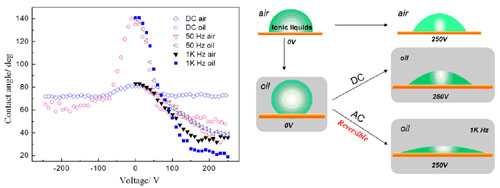Your Current Location is:Home > Research&Development
Design of Ionic Liquid Variable Focus Lenses Based on Electrowetting
R&D Center for Green Chemistry and catalysis at Lanzhou Institute of Chemical Physics of the CAS have studied the electrowetting behavior of ionic liquid (IL) and successfully designed ionic liquid variable focus lenses based on electrowetting, in cooperation with School of Information Science and Technology of Lanzhou University.
The research group has, for the first time, studied the electrowetting behaviour of IL in AC electric field and in oil (dodecane). The results show that compared with that in air or under a DC electric field, electrowetting of ILs in dodecane and under AC electric field showed attractive features, including wide modulation of the contact angle, delay of the contact angle saturation, decrease in contact angle hysteresis, and an increase in sensitivity. In particular, at the high frequency of 1kHz, stable, reversible and wide-contact-angle modulation (122–137°) was obtained. The wide modulation corroborated the potential of ILs to be substantial media for electrowetting-based liquid actuation, particularly in some extreme conditions or in practical applications (generally conducted at 1 KHz oil ambient), such as variable focus ionic-liquid lenses. This work has been published in ChemPhysChem (ChemPhysChem, 2010, 11, 2327-2331).

Electrowetting behavior of ionic liquids in AC electric field and in oil (Image by DENG Youquan et al.)
Based on the above result of electrowetting of IL and in cooperation with School of Information Science and Technology of Lanzhou University, researchers have designed the first IL-based variable focus lenses. The lenses exhibited excellent performance over a conventional saline based lens, such as wide zoom range (3mm–∞), short response time (< 100ms), good tolerance of sharp temperature variation (-20–150 ℃), low energy consumption (< 0.1 mW) and low cost, which can be used in optical field and even in near infrared imaging. This novel IL-based variable focus lenses can overcome most of the shortcomings those found in traditional saline-based EVFLL, including high focusing voltage, evaporating or freezing at relatively higher/lower temperatures, opacity in the near-infrared and even in most of the infrared range.
This work has been published in Soft Matter (Soft Matter, DOI: 10.1039/c1sm05585b) and highlighted by Chemistry World. Robin Rogers, an ionic liquid expert from the University of Alabama in the US believes that: “This is an example in which combining the properties of a pure salt with those of a pure liquid allows for unique applications. Of particular interest are the ranges of refractive indices and electrowetting behaviors that open up a much wider potential focusing range.”
“This IL-based EVFLL has provided a fascinating example of the versatility of ionic liquids compared to traditional salt solutions,” says John Wilkes, head of the United States Air Force Academy research centre in Colorado. “The practical implication of the experiments has not escaped our notice.”

Picture of ionic liquid variable focus lenses and its focusing behavior (Image by DENG Youquan et al.)
Differing from the traditional mechanic lenses, variable focus liquid lenses work like human eyes by changing curvature of liquid surface, which can be widely used in optical imaging, in particular for portable devices such as internal-view mirror and mobile phone, due to its non-mechanical parts, small volume, high reliability and endurance features.
Next Article:Preparation of Ionic Liquids Based Photoelectric Materials